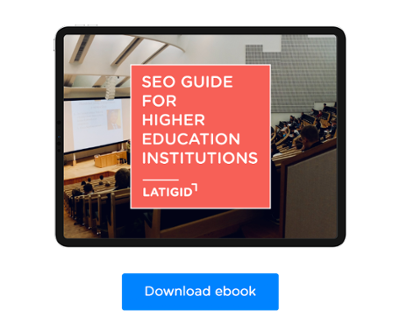
Many institutions undervalue the importance of having a well-optimized website. What they typically tend to forget is that the website is usually the student's first impression of the organization, and when in the process of searching through various universities, a clear, functional, and well-designed website plays a crucial role in creating the image that the institution wants to convey.
Having a strong presence online is both a marketing tool and a necessity for any institution. Your institution’s website should not only transmit credibility but also feature functionality and information that appeals to a variety of target personas including potential students, alumni, and parents, among other stakeholders.
Our experience in designing and developing Higher Education Websites has taught us that there are 7 critical elements that every university website must have.
Here is a list of the must-have components to guarantee high conversion rates for Higher Education Institutions:
1) Genuine Alumni Testimonials
It is difficult for students to envision themselves at your university if they can’t see themselves prospering there. Students tend to relate to someone who has been through the experiences they want to live as well. By seeing alumni’s achievements, the students can see how your institution can help them achieve their personal goals and career aspirations, among all the other aspects that the academic experience has to offer.
2) Make courses easily accessible
When looking for university websites, students are most likely interested in finding the type of courses and programs available. It's critical to make this information easily accessible.
If the users on your website need to search for too long to find the information they are looking for, they may become dissatisfied and leave your website. It’s similar to what happens when a page takes too long to load. When key information is displayed on the screen at the right time, the user experience will be better.
Related: How can your University website help you generate more leads
3) Flawless navigation
Easy navigation around a website is one of the most crucial elements when designing an institutional website. Going from one page to another should not take longer than necessary. In fact studies say that websites that take more than 4 seconds to load lose 1 in 4 visitors.
It's pointless to have a very exciting website if your visitors can't browse through it to get all of the information they're looking for.
4) Use CTA’s
A call to action (CTA) should appear on every page of your university's website. Essentially, you're guiding your users on what to do next, whether it's to fill out a form or to download a program brochure in exchange for their contact information.
Tip: Make sure you place CTA’s where it makes sense. For example, you wouldn’t place a CTA “Find more about our human resources undergraduate degree” on a page explaining the different careers after finishing a master’s degree in digital marketing.
5) Optimized Landing Pages
Landing pages have higher conversion rates because they are focused on a single goal or call to action by offering information about a certain offer or program. The restricted navigation keeps visitors focused on the objective rather than getting distracted by several links that take them away from the website, however, if you want prospects to stay on your landing pages, the content needs to be intriguing, engaging, and instructive.
TIP: You can use A/B testing to test alternative landing page formats and see which one works best and brings the best results. While there are landing page best practices, the outcomes are often dependent on the specific institution and its audience.
6) Don’t be afraid of white space
Whitespace is frequently misunderstood as empty space and hence a waste of screen real estate.
Universities tend to have a lot of information they want to display and to ensure that users get as much information as possible from a website visit, they tend to fill the pages with a lot of text, images, and other elements, which ends up creating a bad user experience.
Whitespace's purpose is not only to create harmony, balance, and a great user experience, it’s also used to lead the users from one page to another, helping them find information as they browse the website.
Remember, your main goal is to make a clear and uncluttered website that delivers information that your students and prospective students will enjoy and appreciate.
7) Mobile-friendly website
When looking for information, mobile phones are one of the most popular and convenient technologies, especially for the younger generations.
As a result, every educational institution should prioritize developing a website that works on a variety of mobile devices. With a mobile-friendly website, it's easier to rank higher in search engines and see improved enrollment rates.
Ultimately, the possibilities that are unfolding as technology continues to alter education are endless. It is no longer an option to have an effective, responsive, and user-friendly website. It is a must for any university that wants to see an increase in enrollment while also keeping their students, and all their stakeholders happy.
If you need help creating or redesigning your Institution’s website, don’t hesitate, talk to us.




